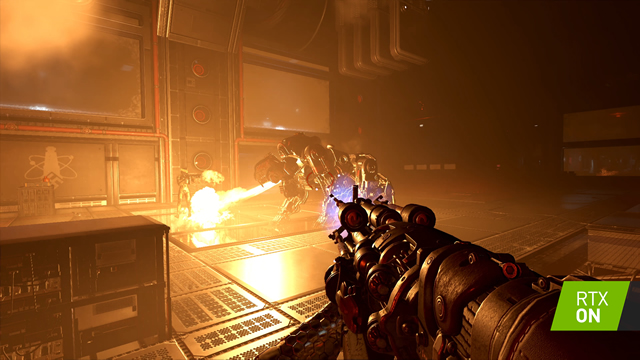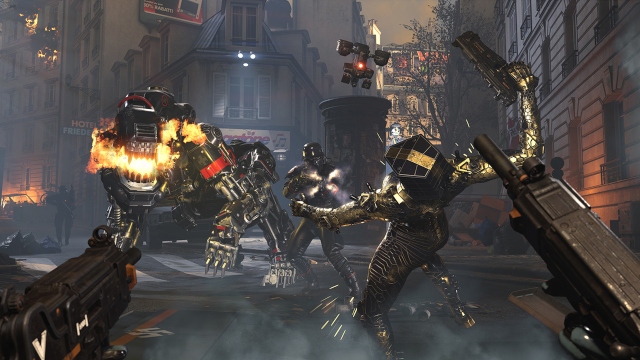Ray-traced graphics have finally arrived in Wolfenstein: Youngblood, Machine Games’ and Arkane Studio’s hit FPS game. Courtesy of the new RTX patch, players can now enjoy the latest and greatest visuals that Nvidia RTX graphics cards have to offer. This new update has a few particular details worth explaining, including new options for Nvidia DLSS, or Deep Learning Super Sampling. Read on to learn more about the new graphical and performance options offered in the Wolfenstein: Youngblood RTX patch.
Wolfenstein: Youngblood RTX Patch | How to enable RTX
For the uninitiated, ray-tracing is a rendering technique that results in strikingly realistic lighting. Without going into too much detail, ray-tracing software can render the path of light as it moves around environments and interacts with objects. It’s next-level visual fidelity, and it’s something that Wolfenstein: Youngblood players have been clamoring for.
ALSO: NVIDIA adds system-level framerate cap, more RTX support in new GeForce drivers
Thankfully, the new patch makes it easy to enable ray-tracing (or RTX) graphics in Youngblood. The first thing you’ll need to do is download the latest Nvidia Game Ready Driver. This can be accomplished through your GPU’s software interface. You’ll also want to make sure to be running the latest Windows 10 update, which is probably a no-brainer. Assuming that is done, all you’ll need is the latest Wolfenstein: Youngblood patch, which will be doled out to players this week.
With the updates and drivers installed, you’ll find a few new options within the game’s Video menu. Navigate to Options, then Video, then Advanced Settings to find the Ray-Traced Reflections option. Slide that little guy to the On position and you’ll be good to go. Talk about easy, right? Of course, within that menu you’ll also see new options for Nvidia DLSS, something that is worth explaining in a bit more detail.
Wolfenstein: Youngblood RTX Patch | DLSS Options
DLSS is another bit of high-tech wizardry offered to Wolfenstein: Youngblood users with Nvidia GPUs. The proper name is Deep Learning Super Sampling, and as that name implies, the tech uses artificial intelligence to balance visual fidelity with game performance. In other words, while RTX gives you the best possible visual flair, DLSS makes sure your machine doesn’t run itself ragged in the process. Given the potential for slowdown when using RTX graphics, enabling DLSS will likely be considered a top priority.
The Wolfenstein: Youngblood RTX patch notably offers two DLSS options in the Advanced Video menu: Nvidia DLSS and Nvidia DLSS mode. The first option is simply a toggle for DLSS, and for the purposes of this guide, you’ll want to switch that to the On position. Once enabled, you can choose from one of three different DLSS presets: Quality, Balanced, and Performance. Quality offers the best visuals possible, Performance goes for the smoothest gameplay possible, and Balanced blends the best of the two together.
These presets effectively change the resolution at which DLSS runs. To keep matters simple, Nvidia has advised players running at 1080p to use the Quality setting, while 4K players should opt instead for Performance. With DLSS enabled, Wolfenstein: Youngblood can see frame rate gains of up to 30fps on average. RTX 2080 Ti users in particular stand to gain up to 47 frames per second running the game in 4K with max settings while DLSS is enabled.
Wolfenstein: Youngblood RTX Patch | Nvidia Highlights

The last major piece of the Wolfenstein: Youngblood RTX patch is the inclusion of Nvidia Highlights. This is a new software tool offered as part of the GeForce Experience aimed squarely at streaming and social media users. In a nutshell, the software automatically records your gameplay and makes clips available to edit and upload to all corners of the internet.
After updating the GeForce Experience to the latest version, launching the game will offer a prompt to enable Nvidia Highlights. From there, you can access the GeForce Experience menu in-game by pressing Alt+Z. In case you don’t want Nvidia Highlights enabled — or if you already have other game capture software — Nvidia Highlights can be toggled on or off by heading into the GeForce Experience, then by navigating to Settings and then to Highlights.






